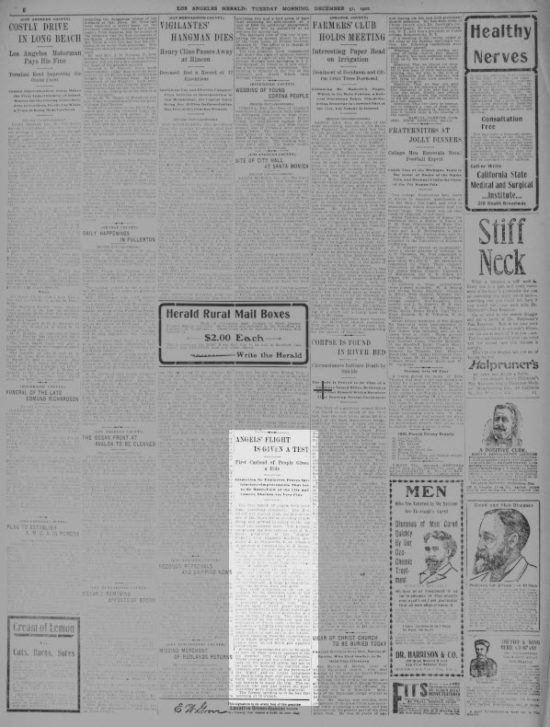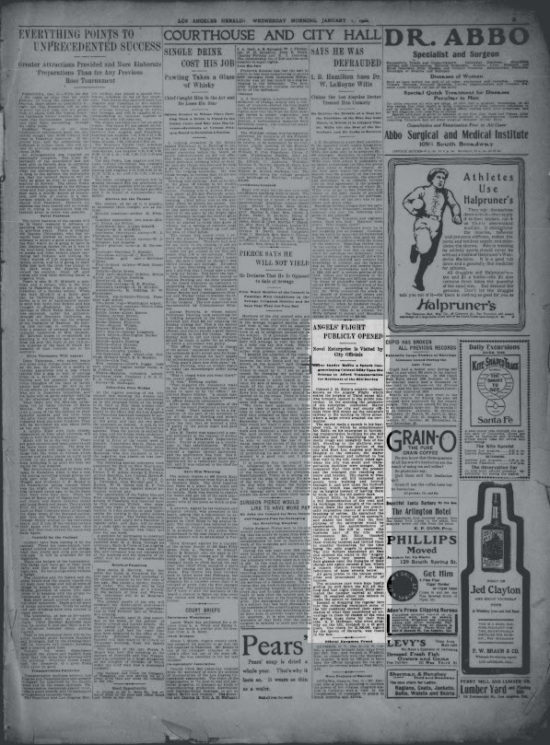Mindblown!Look What I Found! Courtesy the California Digital Newspaper Collection of UC Riverside’s Center for Bibliographical Studies & Research:
An article on page 8 from the December 31, 1901, Los Angeles Herald newspaper: “Angels’ Flight Is Given A Test.”

newspaper, featuring an article on the debut of Angels Flight that morning.
UCR’s fancee shmancee website even transcribes the textesses so I don’t have to — yer welcome:
ANGELS’ FLIGHT IS GIVEN A TEST
First Carload of People Given a Ride
Inspection by Engineers Proves Satisfactory — lmprovements That Are to Be Made — View of the City and Camera Obscura Are Very Fine
The first bunch of angels took their flight yesterday afternoon. The first loaded car started from the Hill street end of the Third street declivity at 1:40 sharp and arrived in safety at the top some two minutes later. The persons composing the first carload were J. W. Eddy, proprietor of the “Angels’ Flight”; City Engineer Stafford, Engineer J. M. Walbrecht, F. H. Olmsted of Quinton & Olmsted, and W. R. Ream. The cable does not work as smoothly as it will work after a day or two of steady use but the cars are commodious and comfortable and inspire just the sort of thrill in the flight that stops short of absolute scariness.
The steps up to the tower from the upper car landing to the observatory at the top are easy of ascent, and the view obtained is a liberal reward of the exertion. A large portion of the town can be seen from that point. The chief attraction at the top, in addition to the extensive view, is the camera obscura, enclosed in a small house, in the roof of which is placed a powerful photographic lens. This throws upon a white plane surface, placed horizontally and about waist high to the beholder, a vivid panorama of a large section of the city. The colors are accentuated by the reduction, and the movement of street cars, vehicles and pedestrians is highly interesting and entertaining. This living picture is some 30×36 inches in size, and in the intensification resulting from the condensation of a whole quarter of the city to that space, even an old brick pile appears picturesque.
Several improvements are to be made at once on what already appears to the lay member very nearly perfection. These changes are not rendered necessary on the score of safety, but are to be made to increase the comfort, convenience and pleasure of the patrons of the “flight” and to render assurance so multip’ledly sure that even the morbidly timid and the ultra nervous will not hesitate to make the trip. The engineers who saw and tested the plant yesterday gave unqualified approval. The formal opening is to be had this morning at 10 o’clock.
But wait! There’s more in the form of the article I found on its grand opening in the January 1, 1902, edition, replete with what in journalism parlance is called a GFE (Gross Factual Error) — and in the lede no less in which the good Colonel is referred to incorrectly as “J.H. Eddy” (transcription reprinted below):

newspaper, featuring an article on the grand opening of Angels Flight the day before.
ANGELS’ FLIGHT PUBLICLY OPENED
Novel Enterprise Is Visited by City Officials
Mayor Snyder Makes a Speech Congratulating Colonel Eddy Upon His Scheme to Afford Transportation for Residents of the Hill Section
Colonel J. H. Eddy’s electric railway, known as the Angels’ Flight, which scales the heights of Third street hill, was formally opened to the public yesterday. In the morning the promoter of the enterprise conducted Mayor Snyder and the city and county officials from Hill street up the miniature railway to the landing on Olive street where a large crowd awaited the ceremonies.
The mayor made a speech in his happiest vein, in which he complimented Mr. Eddy, on his enterprise in furnishing transportation facilities for the hill residents and in beautifying the formerly rough and unsightly face of the hill. Standing on the platform overlooking the business portion of the city and East Los Angeles and Boyle Heights in the distance, the mayor grew reminiscent and referred to his first visit to the hill, twenty years ago, when the city was small and transportation facilities were meager. He compared that time with the present and the enlarged city reaching out below and beyond. The march of time had seen the old hill tunneled and people were walking and driving through it, and now came the inclined railway, which was carrying citizens up its heights instead of leaving them to walk, as in the old pueblo days.
Colonel Eddy, in his response, gave a full demonstration of the road and its workings, the strength of the cables which draw the cars and the practically impossible chance of accident by breaking of cables. He explained the security of the tower and its approach, and stated the belief that the first purpose of the enterprise would be appreciated, the accommodation of residents on the hill to reach the business part of the city with convenience. Mr. Eddy thanked the mayor and councilmen for their friendly interest and invited them to consider themselves, for the time being, the only angels in possession. The city fathers abandoned all fear and climbed the stairs to the “Angels’ View,” where they peered through field glasses upon the domains of their charge and again entered a box, where a camera obscura revealed to them reflections of busy streets below. All gave praise to the unique enterprise und pronounced it worthy of success. The miniature cars were kept busily gliding up and down the hill all day long and last night Colonel Eddy estimated the number carried at about 2000. It required about one minute to make the ascent or descent. Instead of dropping the regular fare into the collecting receptacle some of the hill residents showed their appreciation of what they considered an advantage to them by reason of the road by giving large sums for their first ride. A. P. Hoffman, who owns property on the hill, dropped in a $3 gold piece. One check for $1,000,000, signed by the Queen of Bavaria, was found in the box.
 Follow
Follow